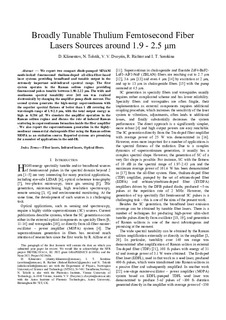Flat-top supercontinuum and tunable femtosecond fiber laser sources at 1.9-2.5 μm
Journal article, Peer reviewed
Accepted version
Date
2016Metadata
Show full item recordCollections
- Institutt for fysikk [2701]
- Publikasjoner fra CRIStin - NTNU [38525]
Original version
Journal of Lightwave Technology. 2016, 34 (21), 4847-4855. 10.1109/JLT.2016.2604039Abstract
We report the high-energy flat-top supercontinuum covering the midinfrared wavelength range of 1.9-2.5 μm as well as electronically tunable femtosecond pulses between 1.98 and 2.22 μm directly from the thulium-doped fiber laser amplifier. Comparison of experimental results with numerical simulations confirms that both sources employ the same nonlinear optical mechanism-Raman soliton frequency shift occurring inside the Tm-fiber amplifier. To illustrate that we investigate two versions of the compact diode-pumped SESAM modelocked femtosecond thulium-doped all-silica-fiber-based laser system providing either broadband supercontinuum or tunable Raman soliton output, depending on the parameters of the system. The first system operates in the Raman soliton regime providing femtosecond pulses tunable between 1.98 and 2.22 μm. Wide and continuous spectral tunability over 240 nm was realized by changing only the amplifier pump diode current. The second system generates high-energy supercontinuum with the superior spectral flatness of better than 1 dB covering the wavelength range of 1.9-2.5 μm, with the total output energy as high as 0.284 μJ, and the average power of 2.1 W at 7.5-MHz repetition rate. We simulate the amplifier operation in the Raman soliton self-frequency shift regime and discuss the role of induced Raman scattering in supercontinuum formation inside the fiber amplifier. We compare this system with a more traditional 1.85-2.53-μm supercontinuum source in the external highlynonlinear commercial chalcogenide fiber using the Raman soliton MOPA as an excitation source. The reported systems1 can be readily applied to a number of industrial applications in the mid-IR, including sensing, standoff detection, medical surgery, and fine material processing.
